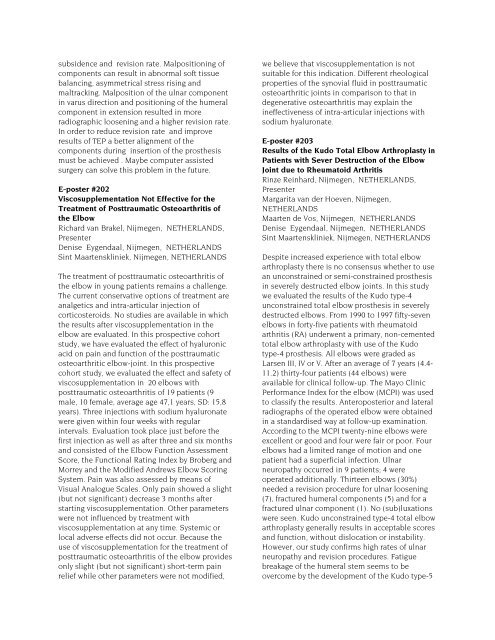POSTER ABSTRACTS - ISAKOS
POSTER ABSTRACTS - ISAKOS
POSTER ABSTRACTS - ISAKOS
Create successful ePaper yourself
Turn your PDF publications into a flip-book with our unique Google optimized e-Paper software.
subsidence and revision rate. Malpositioning of<br />
components can result in abnormal soft tissue<br />
balancing, asymmetrical stress rising and<br />
maltracking. Malposition of the ulnar component<br />
in varus direction and positioning of the humeral<br />
component in extension resulted in more<br />
radiographic loosening and a higher revision rate.<br />
In order to reduce revision rate and improve<br />
results of TEP a better alignment of the<br />
components during insertion of the prosthesis<br />
must be achieved . Maybe computer assisted<br />
surgery can solve this problem in the future.<br />
E-poster #202<br />
Viscosupplementation Not Effective for the<br />
Treatment of Posttraumatic Osteoarthritis of<br />
the Elbow<br />
Richard van Brakel, Nijmegen, NETHERLANDS,<br />
Presenter<br />
Denise Eygendaal, Nijmegen, NETHERLANDS<br />
Sint Maartenskliniek, Nijmegen, NETHERLANDS<br />
The treatment of posttraumatic osteoarthritis of<br />
the elbow in young patients remains a challenge.<br />
The current conservative options of treatment are<br />
analgetics and intra-articular injection of<br />
corticosteroids. No studies are available in which<br />
the results after viscosupplementation in the<br />
elbow are evaluated. In this prospective cohort<br />
study, we have evaluated the effect of hyaluronic<br />
acid on pain and function of the posttraumatic<br />
osteoarthritic elbow-joint. In this prospective<br />
cohort study, we evaluated the effect and safety of<br />
viscosupplementation in 20 elbows with<br />
posttraumatic osteoarthritis of 19 patients (9<br />
male, 10 female, average age 47,1 years, SD: 15,8<br />
years). Three injections with sodium hyaluronate<br />
were given within four weeks with regular<br />
intervals. Evaluation took place just before the<br />
first injection as well as after three and six months<br />
and consisted of the Elbow Function Assessment<br />
Score, the Functional Rating Index by Broberg and<br />
Morrey and the Modified Andrews Elbow Scoring<br />
System. Pain was also assessed by means of<br />
Visual Analogue Scales. Only pain showed a slight<br />
(but not significant) decrease 3 months after<br />
starting viscosupplementation. Other parameters<br />
were not influenced by treatment with<br />
viscosupplementation at any time. Systemic or<br />
local adverse effects did not occur. Because the<br />
use of viscosupplementation for the treatment of<br />
posttraumatic osteoarthritis of the elbow provides<br />
only slight (but not significant) short-term pain<br />
relief while other parameters were not modified,<br />
we believe that viscosupplementation is not<br />
suitable for this indication. Different rheological<br />
properties of the synovial fluid in posttraumatic<br />
osteoarthritic joints in comparison to that in<br />
degenerative osteoarthritis may explain the<br />
ineffectiveness of intra-articular injections with<br />
sodium hyaluronate.<br />
E-poster #203<br />
Results of the Kudo Total Elbow Arthroplasty in<br />
Patients with Sever Destruction of the Elbow<br />
Joint due to Rheumatoid Arthritis<br />
Rinze Reinhard, Nijmegen, NETHERLANDS,<br />
Presenter<br />
Margarita van der Hoeven, Nijmegen,<br />
NETHERLANDS<br />
Maarten de Vos, Nijmegen, NETHERLANDS<br />
Denise Eygendaal, Nijmegen, NETHERLANDS<br />
Sint Maartenskliniek, Nijmegen, NETHERLANDS<br />
Despite increased experience with total elbow<br />
arthroplasty there is no consensus whether to use<br />
an unconstrained or semi-constrained prosthesis<br />
in severely destructed elbow joints. In this study<br />
we evaluated the results of the Kudo type-4<br />
unconstrained total elbow prosthesis in severely<br />
destructed elbows. From 1990 to 1997 fifty-seven<br />
elbows in forty-five patients with rheumatoid<br />
arthritis (RA) underwent a primary, non-cemented<br />
total elbow arthroplasty with use of the Kudo<br />
type-4 prosthesis. All elbows were graded as<br />
Larsen III, IV or V. After an average of 7 years (4.4-<br />
11.2) thirty-four patients (44 elbows) were<br />
available for clinical follow-up. The Mayo Clinic<br />
Performance Index for the elbow (MCPI) was used<br />
to classify the results. Anteroposterior and lateral<br />
radiographs of the operated elbow were obtained<br />
in a standardised way at follow-up examination.<br />
According to the MCPI twenty-nine elbows were<br />
excellent or good and four were fair or poor. Four<br />
elbows had a limited range of motion and one<br />
patient had a superficial infection. Ulnar<br />
neuropathy occurred in 9 patients; 4 were<br />
operated additionally. Thirteen elbows (30%)<br />
needed a revision procedure for ulnar loosening<br />
(7), fractured humeral components (5) and for a<br />
fractured ulnar component (1). No (sub)luxations<br />
were seen. Kudo unconstrained type-4 total elbow<br />
arthroplasty generally results in acceptable scores<br />
and function, without dislocation or instability.<br />
However, our study confirms high rates of ulnar<br />
neuropathy and revision procedures. Fatigue<br />
breakage of the humeral stem seems to be<br />
overcome by the development of the Kudo type-5
















